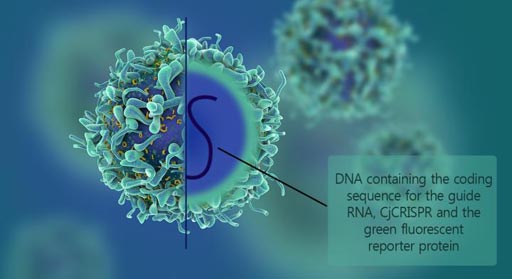Miniaturized Gene Editing for Treatment of Macular Regeneration
By LabMedica International staff writers
Posted on 10 Mar 2017
A viral vector was used to insert a very small CRISPR/Cas9 gene-editing tool into mouse muscle cells or retinal pigment epithelium cells, where it induced mutations that partially cured laser damage that mimicked human chronic age-related macular degeneration.Posted on 10 Mar 2017
CRISPRs (clustered regularly interspaced short palindromic repeats) are segments of prokaryotic DNA containing short repetitions of base sequences. Each repetition is followed by short segments of "spacer DNA" from previous exposures to a bacterial virus or plasmid. CRISPRs are found in approximately 40% of sequenced bacteria genomes and 90% of sequenced archaea. CRISPRs are often associated with cas genes that code for proteins related to CRISPRs. Since 2013, the CRISPR/Cas system has been used in research for gene editing (adding, disrupting, or changing the sequence of specific genes) and gene regulation. By delivering the Cas9 enzyme and appropriate guide RNAs (sgRNAs) into a cell, the organism's genome can be cut at any desired location. The conventional CRISPR/Cas9 system is composed of two parts: the Cas9 enzyme, which cleaves the DNA molecule and specific RNA guides that shepherd the Cas9 protein to the target gene on a DNA strand.

Image: A model of an adeno-associated virus containing the DNA coding for the RNA guide, the Cas9 protein derived from Campylobacter jejuni, and the fluorescent reporter protein (GFP). This is possible because of the small size of Cas9 (Photo courtesy of the Institute for Basic Science).
CRISPR/Cas9 has to be delivered to target cells by plasmids or viruses. The standard Streptococcus pyogenes protein at 1,368 amino acids as well as the most commonly used alternative, Staphylococcus aureus Cas9 at 1,053 amino acids, are both too large to be packaged in a viral vector. Therefore, investigators at the Institute for Basic Science chose to work with Cas9 from Campylobacter jejuni (CjCas9), which at only 984 amino acids is small enough to be packed in the viral vector together with more than one guide RNA as well as with a fluorescent reporter protein.
The investigators reported in the February 21, 2017, online edition of the journal Nature Communications that CjCas9 was highly specific, cleaving only a limited number of sites in the human or mouse genome. CjCas9, delivered via an adeno-associated virus (AAV) vector, induced targeted mutations at high frequencies in mouse muscle cells or retinal pigment epithelium (RPE) cells. Furthermore, CjCas9 targeted to the Vegfa or Hif1a gene in RPE cells reduced the size of laser-induced choroidal neovascularization, suggesting that in vivo genome editing with CjCas9 could be a new option for the treatment of age-related macular degeneration.
"AAV is an efficient and safe vector to express a gene of interest in vivo and has been used widely in gene therapy," said senior author Dr. Kim Jin-Soo, director of the center for genome engineering at the Institute for Basic Science. "CjCas9 is highly specific and does not cause off-target mutations in the genome."













